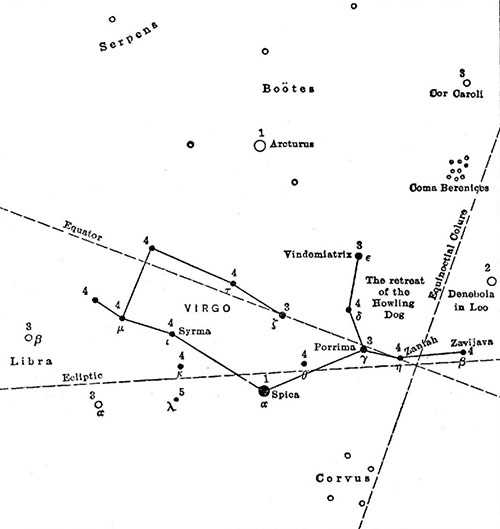From New Dawn 147 (Nov-Dec 2014)
If it could be demonstrated that substantially all the sacred traditions of the world – from the myths of the ancient Egyptians to those of the Norse, from the stories of the Olympian gods and goddesses of Greece to the Vedas of ancient India, to the legends of the Maori and of the Inca and the Maya and the shamanic cultures of Asia, and even to the ‘Bible stories’ found in the scriptures which made their way into the canon of the Old and New Testaments and influenced ‘Western civilisation’ for almost two thousand years – share an identical system of celestial allegory, designed to convey a similar esoteric message about the nature of human existence and the nature of the universe we inhabit, that fact would instantly become one of the most important discoveries of our time.
The ramifications of such a discovery would be profound.
First, it would raise the important question of how such an intimate kinship among cultures spanning essentially the entire globe, reaching to the most remote tribes in some of the world’s most isolated jungles, mountains, and steppes, and existing in time across a gulf of centuries (from the earliest ancient Sumerians and Egyptians to cultures which survived into the nineteenth and even twentieth centuries with their traditional belief-systems largely intact), ever came to be. Nearly every possible explanation for a common esoteric system across so many cultures would overturn or radically upset the conventional historical paradigm, which is generally staunchly ‘isolationist’ and dead-set against theories positing ancient contact across oceans between cultures, and which denies the possibility of an advanced ancient civilisation or civilisations predating the known civilisations of history.
Second, a discovery showing that the original intention of the scriptures of the Old and New Testaments, and the esoteric technique of celestial allegory they employ, is either very similar or identical to the intention and technique of the Greek, Norse, Maya, Maori and Egyptian myths, would immediately subvert the wall of separation which has been erected between the religions patterned on those Old and New Testament scriptures and the sacred systems of all the world’s ‘pagans’.
We have been led to believe, for at least the past seventeen centuries, that the faiths which sprang from the biblical texts were based upon historical events and historical figures, in contrast to the pagan mythologies peopled by deities and entities which personify forces of nature, and that this difference set the biblical faiths completely apart from the nature-worshipping pagan systems. Even those who deny the supernatural aspects of the biblical stories tend to fall into this trap (including the most up-to-date academics), searching for evidence of a ‘historical Jesus’ and wondering whether he might have had a ‘secret wife’, or asking questions about who Moses really might have been (perhaps Akhenaten?), when they would never dream of trying to discover the ‘historic’ Hercules or Horus or Aztec god Tezcatlipoca, or whether any of them might have had a ‘secret wife’ and descendants who are still alive today.
Third, such a discovery arouses the question of why such an unusual method of transmission and preservation was selected, and what exactly that message might be. And finally (for now at least – there are many other profitable questions which could be raised), there is the important question of how the esoteric understanding of ancient scriptures and myths was so thoroughly lost. This question is especially important when it comes to the interpretation of the scriptures of the Old and New Testaments, because the literalist interpretation (as opposed to the esoteric interpretation that the texts themselves invite) has played so dominant a role in world history – and continues to do so to this day.
In fact, it can be demonstrated quite convincingly that the myths of the world’s sacred traditions – including those in the biblical scriptures – consist almost entirely of celestial allegory. The system of celestial allegory is complex, and multi-layered, but a strong sense of its basic workings can be obtained through the consideration of the stories related to the zodiac wheel, one of the central aspects of the entire system.
A suspicion that the stories in the Old and New Testament might be celestial in nature can be raised by the simple fact that the tribes of Old Testament Israel, and the disciples called by Jesus in the New Testament gospels, are twelve in number. Indeed, it can be satisfactorily demonstrated that the scriptures of the Old Testament clearly indicate the twelve ‘tribes’ of Israel are intended to describe the twelve constellations (groupings of stars – ‘tribes’ of stars, if you will) of the zodiac, and the same for the twelve disciples of the New Testament.
The Esoteric Meaning of the Story of Samson
The demonstration of the connection (especially to someone sceptical of the theory) requires some extended discussion and diagrams, and it is much easier to examine some other well-known biblical stories, where the connection is immediately obvious and difficult to deny.
One of these is the story of Samson, the famous strong-man of the book of Judges, who is described in chapter fourteen as taking a trip “down” to Timnath to meet a woman “who pleased him well,” encountering a lion on the way down and slaying it with his bare hands. After a time he returned and found that the carcass of the lion was now buzzing with a swarm of bees and honey (presumably the bees built a hive in the carcass of the dead lion).
This event provides the material for a “riddle” which Samson puts to the Philistines, and they are unable to answer it. The fact that it is described as a riddle should cause us to consider it very closely – the text is practically inviting us to ask of the hidden meaning to this puzzle, and one is soon found if we consider the zodiac wheel. In the zodiac wheel (left), the sun’s progress through the year is indicated with the signs shown as they would have been during the ‘Age of Aries’ (for good and cogent reasons which lie outside the scope of this particular article).
Each year, due to the obliquity of the ecliptic (the earth’s tilt upon its axis), the path of the sun during the day traces an arc that is either above or below the line of the celestial equator. The celestial equator is the imaginary great circle which can be said to encircle the inside of the ‘heavenly sphere’ at a distance of ninety arc-degrees down from the north pole, or up from the south pole for observers in the southern hemisphere, although the rest of this discussion will take a northern-hemisphere-centric perspective, since the biblical texts (and the land of Egypt from whence they almost certainly originated) come to us from lands situated in the northern hemisphere. The sun’s ecliptic path crosses above this line at the point of the spring equinox each year (the March equinox for the northern hemisphere), after which days are longer than nights as the sun progresses towards the ‘summit’ of the summer solstice in June, and then the path crosses back down below that line at the point of the fall equinox, and the onset of the part of the year in which nights are longer than days.
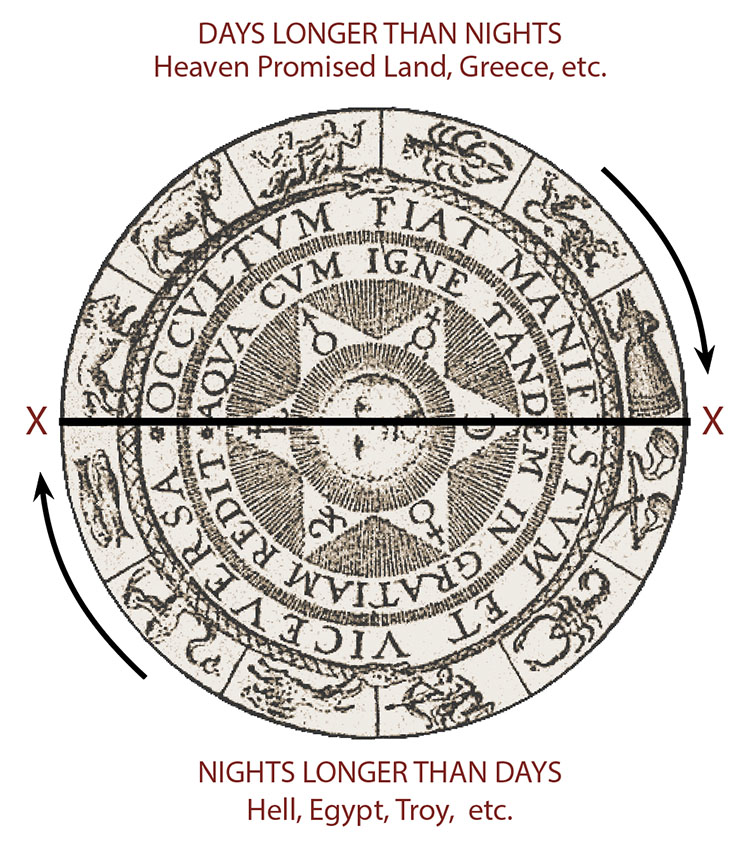
In the above diagram, the line of the celestial equator is indicated as a horizontal line, above which are the months with days longer than nights, and below which are the months with nights longer than days. The direction of the sun’s progress throughout the year is indicated by arrows, and the points at which the sun crosses the line are marked each with a large ‘X’ indicating the two equinoxes.
From the point of summer solstice, at the top of the zodiac wheel, if the sun is going down towards the autumn equinox (the way Samson in Judges 14 is initially going down towards Timnath), he will first encounter the zodiac sign of Leo the Lion (just as Samson encountered a young lion on his way). Next, he will encounter the sign of Virgo the Virgin, who obviously corresponds to that beautiful woman of Timnath.
But what about the swarm of bees? As it happens, if Samson continued around the wheel and came back again to the point of Leo the Lion, the sign he would encounter just prior to reaching Leo would be Cancer the Crab (indicated in the somewhat archaic zodiac used above by a design that looks more like the animal we would call a lobster). It is an indisputable fact that the constellation of Cancer contains a shimmering cluster of stars known as the Beehive Cluster (and for this reason, ancient depictions of lions sometimes show them as having a bee coming out of their mouth or having a bee flying just in front of their dignified leonine visage).
Clearly, all of these zodiac correspondences in the event which furnished the material for the ‘riddle of Samson’ are unlikely to be sheer coincidence. It is difficult to argue that the events of the book of Judges involving Samson (and there are many more of them which have similar celestial correspondences) took place in the historical life of a literal human being, and just happened to match up perfectly with the constellations of the zodiac between Cancer and Virgo (with the directions ‘up’ and ‘down’ matching perfectly as well).
While it may be – just barely – possible to argue these events could be the accurate record from the life experiences of a literal, historical human being named Samson, the fact this same pattern of celestial allegory (often involving zodiac signs) is repeated over and over throughout the scriptures of the Old and New Testaments (and the myths of the world) effectively puts the ‘coincidence’ argument to rest.
The Story of Abraham & Isaac
To see another example which argues strongly for a celestial and allegorical approach to the events of Old and New Testament scripture, it is first important to understand that the ‘crossing’ points of the equinoxes, where the sun’s daily path crosses the celestial equator (once upward at the spring equinox and once downward at the fall or autumnal equinox) were anciently allegorised as places of sacrifice. In the New Testament stories, of course, these ‘crossings’ would involve an actual sacrifice upon a cross. But in the Old Testament, we see a famous sacrificial scene in the near-sacrifice of Isaac by his father Abraham upon Mount Moriah.
The story is found in the book of Genesis, in the 22nd chapter. There, we are told that God directs Abraham to take his beloved and only son Isaac up a mountain in the land of Moriah and offer him up for a burnt offering. Abraham and Isaac dutifully trudge up the mountain, and Isaac makes note of the fire and the wood for the sacrifice, and asks his father, “but where is the lamb for a burnt offering?” (verse 7).
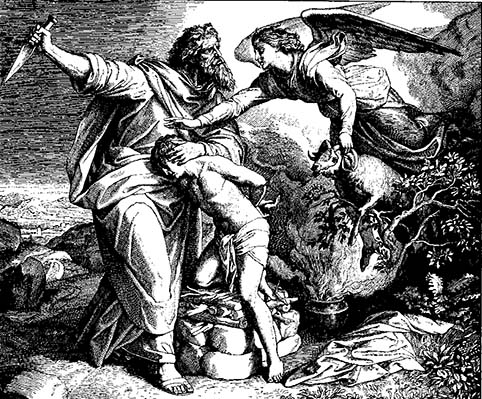
Here again we clearly have the elements which point to an esoteric rather than a literal interpretation of the text. The fact that the characters in the story are trudging up the mountain indicates we should suspect the story involves the sun’s path up towards the summer solstice. Since equinoxes are often indicated with a sacrifice, the equinox on the way up towards the summit of the year would be the spring equinox, not the fall equinox.
The mention of ‘fire’ in the text is also indicative of the ancient symbology of the sun’s path or the ecliptic: in ancient Mithraic symbology, for instance, the equinoxes are indicated by two distinctive characters who each carry a torch, with one of them carrying his torch pointing upwards to indicate the spring equinox (sun climbing up towards summer solstice) and one of them carrying it pointing downwards to indicate the autumnal equinox (in which the sun is declining downwards towards winter). The identification of the sun’s ecliptic, and especially the equinox, with the symbol of fire is amply supported by the discussion and evidence presented by Giorgio de Santillana and Hertha von Dechend in their magnum opus Hamlet’s Mill (1969).
Having identified some clues indicating this story may depict events at an equinox, and specifically at the spring equinox when the sun is “ascending the mount” which culminates at summer solstice, we read on to see if there are any confirming symbols which might correspond to a zodiac sign. Sure enough, as Abraham is in the very act of stretching forth his hand and taking the knife to slay his son, we are told that an angel of the LORD directs Abraham to stay his hand, and as Abraham “lifted up his eyes, and looked,” behold, he saw “a ram caught in a thicket by his horns” (verse 13). This miraculous appearance of a ram caught in a thicket is confirmatory evidence that the story of Abraham and Isaac ascending Mount Moriah is actually an esoteric allegory pointing to the sun’s passage through the spring equinox, which takes place right at the beginning of the sign of Aries, the Ram.
Goddess at the Gates of the Underworld
Such celestial allegories can be found throughout the scriptures of the Old Testament, as well as in the sacred traditions of other cultures the world over. We know that the crucifixion of Christ in the New Testament is also surrounded by equinoctial imagery, but in this case the primary imagery is autumnal. Some evidence includes the presence of Mary (or more than one Mary) at or near the base of the cross during the crucifixion – representative of the zodiac sign of Virgo the Virgin.
The constellation Virgo is associated with a sheaf of wheat and harvest season (marking as she does the autumnal equinox), with the star Spica traditionally associated with wheat. Virgo’s outstretched arm is marked by a star anciently designated Vindemiatrix, which literally means ‘grape-gatherer’, as if she is plucking the fruit of the vine. These two symbols, of grapes and of wheat, are representative of the autumnal activities of the harvest season, and we find them prominently repeated in the Last Supper meal of bread and wine, immediately prior to the crucifixion.
The constellation Virgo stands just at the edge of the autumnal equinox, the gateway to the lower half of the year, allegorised in sacred traditions around the globe as ‘the underworld’, or Hades, Sheol, and Hell. Appropriately enough, we see the ancient Apostles’ Creed asserts that immediately after Christ died, he “descended into hell,” although this assertion has confused some literalist Christian theologians who do not realise the scriptures encode the motions of the starry heavens.
In many myths around the world there is the figure of a maiden or a virgin or a goddess who stands at the gates of the underworld. This confirms that the esoteric pattern being described is extremely ancient – probably traceable to an ancient advanced civilisation prior to the dawn of any known historical civilisation – or at least to advanced or ascended sages from that pre-historic time. Often, this maiden or goddess greets the souls of the newly deceased or (in some cases) living heroes who are embarking upon a trip to the underworld, and in many cases she offers them wine or mead. All of this is in keeping with the pattern we are examining, and can be explained by the fact Virgo is located at the very ‘gates of the underworld’, and that she is associated with both grapes and the sheaf of wheat.
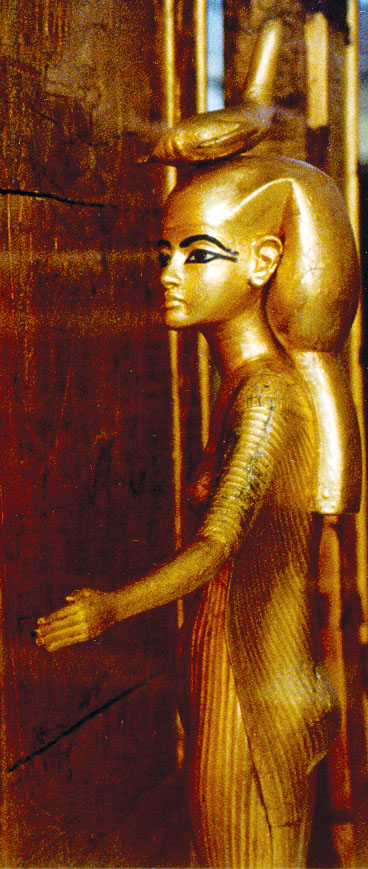
We see her as Medea directing Odysseus on his quest to the realm of the dead, in the Odyssey of Homer. We see her as the ‘old goddess with the scorpion tail’ who greets the souls of the dead and gives them drink, found in the mythology of the Maya and many other Native American cultures according to de Santillana and von Dechend (Hamlet’s Mill, 243-244). The addition of a scorpion tail, of course, comes from the fact that the constellation Scorpio or Scorpius is found not far from Virgo, just beyond Libra and below the line of the celestial equator on the ‘underworld side’ of the fall equinox.
De Santillana and von Dechend note that this scorpion-goddess at the gateway to the realm of the dead and found in the mythology of the Americas is very reminiscent of the scorpion-goddess Selket from ancient Egypt, a beautiful gilt statue of whom was discovered standing guard over the canopic chest in the tomb of King Tutankhamun. Of course, the conventional historians assure us there could have been no contact between the cultures of ancient Egypt and the civilisations of Central or South America, and yet each has a scorpion-goddess associated with the entry of souls into the realm of the dead.
A maiden with mead at the edge of the underworld is also present in Norse mythology, as discovered by Maria Kvilhaug and detailed in her important Masters’ dissertation The Maiden with the Mead (2004). All of these myths, from cultures found around the globe, undoubtedly allegorise the sign of Virgo at the gate of the autumnal equinox and the lower half of the year (the half which was depicted in ancient myth as Hell, Hades, or the underworld). Most of them involve the offering of mead or wine, beverages made from wheat or from grapes, both of which were associated with the constellation Virgo. Some of the goddesses incorporate the sign of Scorpio as well.
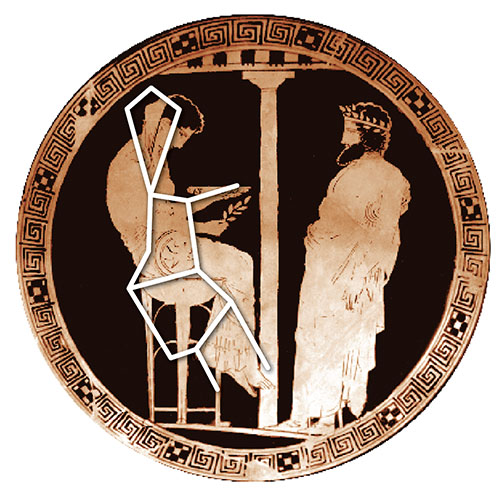
We also see a Virgo-like figure in the Pythia of the important ancient Greek oracle at Delphi, who was depicted as being seated on a tripod near a great rift leading to the underworld containing the body of the dragon-serpent Python: the fumes which proceeded from that rift caused the Pythia to go into a trance-state in which she could relay knowledge from the realm of the gods. In the ancient art, this maiden was often depicted as holding a sacred laurel branch and a plate of sacred water from the nearby spring – both characteristics that can be associated with the outline of the constellation Virgo, as is the seated posture of the constellation. The circle of water corresponds to the dim outline of stars that can be seen in the Virgo constellation chart above the outstretched arm of the maiden, which is sometimes depicted in other myths as a tambourine, or other circular instrument.
Why Encrypt Esoteric Teachings?
The foregoing examples should suffice to establish the fact that the ancient mythologies of the world (of which the scriptures of the Old and New Testament were originally part) were intended to be understood allegorically and esoterically, rather than literally. This immediately triggers the question of why? Why would the ancients ascribe such importance to the motions of the heavens and the heavenly bodies, the rising and setting of the sun, moon, planets and stars each day and throughout the year?
The answer to that question is multi-layered, and it is profound. Essentially, the ancient sages wished to convey truths esoterically, truths so deep that they would tend to ‘trip up’ the logical intellect, the aspect of our thinking usually described as ‘left-brained’.
To illustrate the power of esoteric teaching, perhaps the best example is the famous scene from the original Karate Kid movie (1984), in which a frustrated Danny is finally fed up with waxing cars, sanding the floor, painting the fence (up, down), and painting the house (side-side). He confronts his teacher, Mr. Miyagi, and demands to know when he is going to finally be permitted to learn martial arts. The ensuing scene is so powerful that it has become world-famous: Mr. Miyagi demonstrates to Daniel-San that he has already been learning the secret art, in the motions of all his chores. Mr. Miyagi shows Daniel-San the ‘hidden teaching’ inside the motions of waxing the car, or painting the fence, and by unexpectedly launching ferocious attacks on Danny (accompanied by terrifying shouts), makes Daniel-San experience for himself that the martial art will actually work as advertised.
This is the essence of the esoteric: it is not designed to keep knowledge secret, but rather to impart knowledge. If Mr. Miyagi had tried to explain various blocks to Danny, Danny would probably have had all kinds of questions, and doubts, and ‘what if’s’. By first giving Danny the motions in a ‘disguised’ format (and ensuring that Daniel-San internalised those motions), Mr. Miyagi enabled Danny to experience them for himself, achieving what the ancients called gnosis – a type of knowledge that comes not from the intellect or from ‘believing’ but rather from experience.
It is quite possible – in fact it is almost certain – that the esoteric myth-systems of the world were designed to convey gnosis in much the same way. In fact, there is evidence these metaphors were not just a bunch of “stories built to hide the teachings about the motions of the stars,” but that the motions of the stars themselves were also allegories which convey profound teachings about the nature of human existence, and about the nature of the universe. Like the martial art Mr. Miyagi wanted to impart to Daniel-San, these profound teachings are of the sort that the intellectual ‘left-brain’ mind will choke upon.
There is evidence they teach a ‘holographic universe’ and a cosmology anticipating the discoveries of modern quantum physics by many thousands of years. Anyone who has encountered quantum physics knows it is very difficult to accept, and elicits the kind of incredulous questions that Mr. Miyagi would probably have gotten from Daniel-San had he tried to teach karate using ‘left-brain explanations’ instead of his esoteric ‘wax on, wax off’ method.
In brief, they were using the motions of the stars to teach about the existence of a spiritual realm which interpenetrates and coexists with the material realm, and to which one could travel using shamanic techniques in order to effect changes which would impact the material world or to gain knowledge that could otherwise not be accessed using strictly material or even ‘scientific’ methods.
If the ancient sages, or the ancient civilisation or civilisations which preceded the earliest-known civilisations of history such as Sumer and Egypt, possessed such an advanced cosmography, it may go a long way towards explaining their incredible architectural achievements, achievements which conventional historical paradigms are at a loss to explain.
How Did We Lose Access to the Ancient Wisdom?
This possibility brings us to the final question this incredible information raises: what happened to it? How did a large portion of humankind lose access to this ancient wisdom? Much of it seems to have been lost before the dawn of the earliest-known historical civilisations, although it is clear some portion of it survived in the ancient cultures of the world – in large part, perhaps, because of the exquisitely-crafted esoteric myths we have been discussing.
But somewhere along the line, the esoteric understanding of these myths was replaced by a literalist approach, and it appears this process was a deliberate subversion carried out by the originators of literalist Christianity in the case of the scriptures of the Old and New Testaments. There, the literalists were able to wage a successful campaign to silence, marginalise, or eliminate the gnostic teachers and the texts which taught a gnostic approach (the Nag Hammadi texts, found in the twentieth century buried beneath a cliff along the Nile River in Egypt, testify to this ancient campaign). Then, allied with the power of the Roman Empire, the literalists expanded their campaign against esotericism and the shamanic to other cultures of Europe.
Literalist Christianity later took this campaign across the oceans, to eradicate the ancient wisdom in the cultures of the Americas, and later into Polynesia and even into Asia, including the civilisations of India, China, Tibet, and others.
There is much more to this story, and it is one whose ending has yet to be written. There is no doubt the ancient wisdom entrusted to the human race is esoteric in nature, and attempts to suppress this truth – often through violence, threats, and deliberate falsehood – have caused tragic loss and suffering throughout human history since at least the rise of literalism during the first through fourth centuries CE. Stemming that violence, and healing that damage, will require courage, and it will require wisdom. The first steps, perhaps, include understanding this ancient esoteric system, and the profound wisdom the sages of pre-history intended it to convey to us and to future generations.
Virtually all the world’s sacred traditions are built upon a common esoteric system of celestial allegory. David Warner Mathisen’s book The Undying Stars: The Truth That Unites the World’s Ancient Wisdom and the Conspiracy to Keep It from You, reveals how that system works and why the ancients thought it was so important. The book is available from www.amazon.com. For further information go to the author’s website: Star Myths of the World
© New Dawn Magazine and the respective author.
For our reproduction notice, click here.



